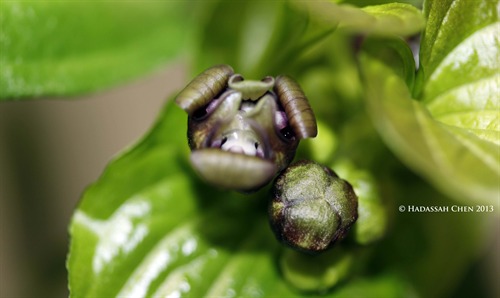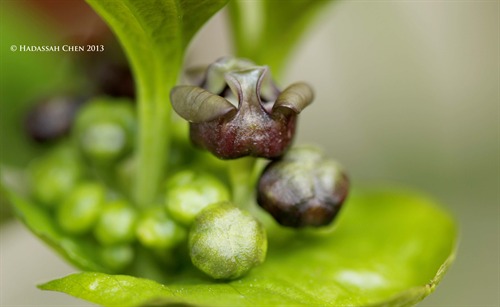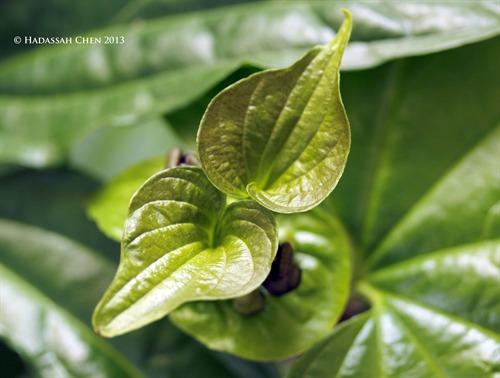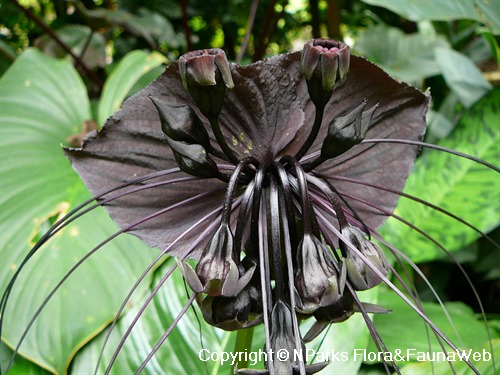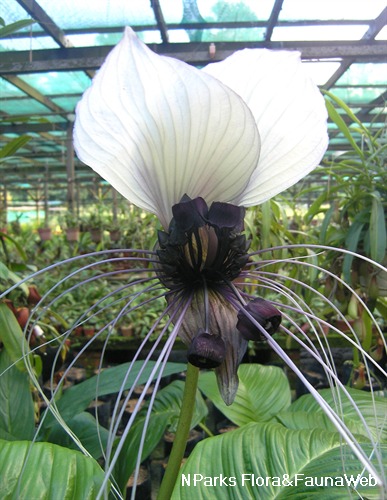
Back
Tacca palmata Blume
| Family Name: | Dioscoreaceae |
| Synonyms: | Tacca angustilobata Merr., Tacca elmeri K.Krause, Tacca fatsiifolia Warb. ex H.Limpr., Tacca montana Schult. & Schult.f., Tacca rumphii Schauer, Tacca vesicaria Blanco |
| Common Name: | Gadung Tikus, Payung-payungan, Buk Ruesi, Khot Din |
Tacca palmata, or known as Gadung Tikus, is a shade-loving herbaceous plant that can be found in Thailand, Cambodia, Vietnam, Malaysia and Indonesia. It produces hand-like leaves, bizarre inflorescences with green bracts, and bright red berries. It is one of the few Taccaspecies lacking the whisker-like bracteoles.
Name
Classifications and Characteristics
| Plant Division | Angiosperms (Flowering Seed Plants) (Monocotyledon) |
|---|---|
| Plant Growth Form | Herbaceous Plant |
| Lifespan (in Singapore) | Perennial |
| Mode of Nutrition | Autotrophic |
Biogeography
| Native Distribution | Southern Thailand, Cambodia, Southern Vietnam, Peninsular Malaysia, Sumatra, Java, Lesser Sunda Islands, Borneo, the Philippines, Sulawesi, Maluku, & West New Guinea |
|---|---|
| Native Habitat | Terrestrial (Secondary Rainforest) |
| Preferred Climate Zone | Tropical |
| Local Conservation Status | Non-native (Horticultural / Cultivated Only) |
Description and Ethnobotany
| Growth Form | It is a perennial, rhizomatous herbaceous plant. |
|---|---|
| Foliage | The leaves are palmately lobed, being broadly kidney-shaped to semi-orbicular in outline, up to 7–36 cm long × 7.5–40 cm wide. Each of the 4–8 lobes can reach up to 6–25 cm long × 1–10 cm wide, with the outer lobes mostly smaller than the inner ones. The petioles (leaf stalks) are 15–60 cm long × 1–4 mm wide. The leaves occur 1–3 (–5) at a time. |
| Stems | It has round, light-brown underground tuber-like rhizomes (thick, horizontal, modified stems). |
| Flowers | The inflorescence is an umbellate cymose, subtended by two pairs of green tinged with violet involucral bracts: the outer pair is broadly oval and sessile, and the inner pair is smaller, broadly oval to heart-shaped, petiolated, and held above the flowers. The thread-like bracteoles are absent. The flowers have six green, violet-brown or dark violet tepals (a term for indistinguishable petals and sepals), six stamens and a single tri-lobed stigma. Each flower is attached to a 1–2 cm long pedicel (a flower stalk). The inflorescences and flowers grow above the foliage. |
| Fruit | The fruit are fleshy, globular, 3-ribbed berries, up to 1 cm in diameter, that ripens to bright red, and contain approximately 11 pyramidal & ribbed seeds. |
| Habitat | It can be found primarily in secondary vegetation and forest margins, as well as in teak forests and bamboo groves up to 1000 m above sea level. |
| Associated Fauna | Its flowers are pollinated by female biting midges (family Ceratopogonidae) and may exhibit autogamy (self-pollination). <1> |
| Cultivation | It grows well in moist, shaded areas with moist but well-draining soil and plenty of organic material. It prefers high humidity due to its humid, understorey habitat. It can be propagated by seeds, rhizomes, or division. |
| Etymology | The genus Tacca is from a Malayan vernacular name, taka, 'arrowroot'. The specific epithet palmata refers to the palmate or hand-like leaves. |
| Ethnobotanical Uses | Medicinal: In Malaysia & Indonesia, scrapings from the tuberous rhizomes are used to treat wounds, such as snake bites. Crushed petioles and scrapings are applied on the stomach to relieve aches. In the Philippines, the scrapings are also taken by women against menstrual disorders. |
Landscaping Features
| Landscaping | It is suitable for shaded to partially shaded, moist areas in parks and gardens. |
|---|---|
| Desirable Plant Features | Ornamental Foliage, Ornamental Fruits |
| Landscape Uses | General, Parks & Gardens, Small Gardens, Interiorscape/ Indoor Plant, Container Planting |
| Thematic Landscaping | Naturalistic Garden |
| Usage Hazard - Cons | Toxic Upon Ingestion |
| Usage Hazard - Cons Remarks | Toxic if ingested: The plant contains taccalonolides and, while not known to be toxic to humans, may cause an allergic reaction when ingested. It may be toxic to cats and dogs, so keep away from pets. |
Fauna, Pollination and Dispersal
| Fauna Pollination Dispersal Associated Fauna | Bird-Attracting |
|---|---|
| Seed or Spore Dispersal | Biotic (Fauna) (Vertebrates (Birds)) |
Plant Care and Propagation
| Light Preference | Semi-Shade, Full Shade |
|---|---|
| Water Preference | Moderate Water, Occasional Misting |
| Plant Growth Rate | Moderate |
| Rootzone Tolerance | Moist Soils, Well-Drained Soils, Fertile Loamy Soils |
| Maintenance Requirements | Moderate |
| Pest(s) | Sucking Insects, Chewing Insects |
| Propagation Method | Storage Organ (Rhizome), Seed |
Foliar
| Foliage Retention | Evergreen |
|---|---|
| Mature Foliage Colour(s) | Green |
| Mature Foliage Texture(s) | Smooth |
| Young Flush Texture(s) | Smooth |
| Foliar Modification | Flower/Fruit Bract |
| Foliar Type | Simple / Unifoliate |
| Foliar Arrangement Along Stem | Rosulate / Rosette |
| Foliar Attachment to Stem | Petiolate |
| Foliar Shape(s) | Non-Palm Foliage (Reniform, Orbicular / Round) |
| Foliar Venation | Palmate |
| Foliar Margin | Entire |
| Foliar Apex - Tip | Acuminate |
| Foliar Base | Attenuate |
| Leaf Area Index (LAI) for Green Plot Ratio | 3.5 (Shrub & Groundcover - Monocot) |
Non - Foliar and Storage
| Root Type | Underground (Fibrous Root) |
|---|---|
| Specialised Storage Organ(s) | Underground (Rhizome) |
Floral (Angiosperm)
| Flower & Plant Sexuality | Bisexual Flowers |
| Flower Colour(s) | Brown, Purple |
|---|---|
| Flower Texture(s) | Thin |
| Flower Grouping | Cluster / Inflorescence |
| Flower Location | Axillary |
| Flower Symmetry | Radial |
| Ovule Placentation | Parietal |
| Ovary Position | Inferior / Epipgynous |
| Flowering Habit | Polycarpic |
| Inflorescence Type Remarks | Umbellate cymose |
Fruit, Seed and Spore
| Mature Fruit Colour(s) | Red |
|---|---|
| Mature Fruit Texture(s) | Smooth |
| Fruit Classification | Simple Fruit |
| Fruit Type | |
| Mature Seed Colour(s) | Brown |
| Mature Seed Texture(s) | Wrinkled |
| Seed Quantity Per Fruit | Several (11-20) |
References
| References | <1> Chua, K.S., Borkent, A. & Wong, S.Y. (2020). Floral biology and pollination strategy of seven Tacca species (Taccaceae). Nordic Journal of Botany, Vol 38: 1-4 <2>Drenth, E. (1976). Taccaceae. Flora Malesiana, Ser. 1, Seed Plants, Vol. 7: 806-819. <3>5. Tacca palmata Blume e-Flora of Thailand. https://botany.dnp.go.th/eflora/floraspecies.html?tdcode=01511 (Accessed 7 November 2025) |
|---|
Image Repository
Others
| Master ID | 31833 |
|---|---|
| Species ID | 6233 |
| Flora Disclaimer | The information in this website has been compiled from reliable sources, such as reference works on medicinal plants. It is not a substitute for medical advice or treatment and NParks does not purport to provide any medical advice. Readers should always consult his/her physician before using or consuming a plant for medicinal purposes. |

